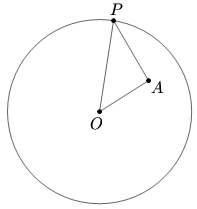Difference between revisions of "1977 Canadian MO Problems"
m (→Problem 7) |
|||
| Line 3: | Line 3: | ||
== Problem 1 == | == Problem 1 == | ||
| − | If <math> | + | If <math>f(x)=x^2+x,</math> prove that the equation <math>4f(a)=f(b)</math> has no solutions in positive integers <math>a</math> and <math>b.</math> |
[[1977 Canadian MO Problems/Problem 1 | Solution]] | [[1977 Canadian MO Problems/Problem 1 | Solution]] | ||
| Line 9: | Line 9: | ||
== Problem 2 == | == Problem 2 == | ||
| − | Let <math> | + | Let <math>O</math> be the center of a circle and <math>A</math> be a fixed interior point of the circle different from <math>O.</math> Determine all points <math>P</math> on the circumference of the circle such that the angle <math>OPA</math> is a maximum. |
[[Image:CanadianMO-1977-2.jpg]] | [[Image:CanadianMO-1977-2.jpg]] | ||
| Line 18: | Line 18: | ||
== Problem 3 == | == Problem 3 == | ||
| − | <math> | + | <math>N</math> is an integer whose representation in base <math>b</math> is <math>777.</math> Find the smallest positive integer <math>b</math> for which <math>N</math> is the fourth power of an integer. |
[[1977 Canadian MO Problems/Problem 3 | Solution]] | [[1977 Canadian MO Problems/Problem 3 | Solution]] | ||
| Line 36: | Line 36: | ||
== Problem 5 == | == Problem 5 == | ||
| + | |||
| + | A right circular cone of base radius <math>1</math> cm and slant height of <math>3</math> cm is given. <math>P</math> is a point on the circumference of | ||
| + | the base and the shortest path from <math>P</math> around the cone is drawn (see diagram). What is the minimum distance from | ||
| + | the vertex <math>V</math> to this path? | ||
| + | |||
| + | {figure} | ||
[[1977 Canadian MO Problems/Problem 5 | Solution]] | [[1977 Canadian MO Problems/Problem 5 | Solution]] | ||
Revision as of 14:20, 7 October 2014
The seven problems were all on the same day.
Contents
Problem 1
If ![]() prove that the equation
prove that the equation ![]() has no solutions in positive integers
has no solutions in positive integers ![]() and
and ![]()
Problem 2
Let ![]() be the center of a circle and
be the center of a circle and ![]() be a fixed interior point of the circle different from
be a fixed interior point of the circle different from ![]() Determine all points
Determine all points ![]() on the circumference of the circle such that the angle
on the circumference of the circle such that the angle ![]() is a maximum.
is a maximum.
Problem 3
![]() is an integer whose representation in base
is an integer whose representation in base ![]() is
is ![]() Find the smallest positive integer
Find the smallest positive integer ![]() for which
for which ![]() is the fourth power of an integer.
is the fourth power of an integer.
Problem 4
Let
![]() and
and
![]() be two polynomials with integer coefficients. Suppose that all of the coefficients of the product
be two polynomials with integer coefficients. Suppose that all of the coefficients of the product ![]() are even, but not all of them are divisible by 4. Show that one of
are even, but not all of them are divisible by 4. Show that one of ![]() and
and ![]() has all even coefficients
and the other has at least one odd coefficient.
has all even coefficients
and the other has at least one odd coefficient.
Problem 5
A right circular cone of base radius ![]() cm and slant height of
cm and slant height of ![]() cm is given.
cm is given. ![]() is a point on the circumference of
the base and the shortest path from
is a point on the circumference of
the base and the shortest path from ![]() around the cone is drawn (see diagram). What is the minimum distance from
the vertex
around the cone is drawn (see diagram). What is the minimum distance from
the vertex ![]() to this path?
to this path?
{figure}
Problem 6
Let ![]() and define
and define
![]() Show that
Show that ![]() for all values of
for all values of ![]() .
.
Problem 7
A rectangular city is exactly ![]() blocks long and
blocks long and ![]() blocks wide (see diagram).
A woman lives on the southwest corner of the city and works in the northeast corner. She walks
to work each day but, on any given trip, she makes sure that her path does not include any intersection
twice. Show that the number
blocks wide (see diagram).
A woman lives on the southwest corner of the city and works in the northeast corner. She walks
to work each day but, on any given trip, she makes sure that her path does not include any intersection
twice. Show that the number ![]() of different paths she can take to work satisfies
of different paths she can take to work satisfies ![]() .
.
$\underbrace{ \left \begin{tabular}{|c|c|c|c|c|c|c|c|c|c|c| }
\hline
&&&&&&&&&& \\ \hline
&&&&&&&&&& \\ \hline
&&&&&&&&&& \\ \hline
&&&&&&&&&& \\ \hline
&&&&&&&&&& \\ \hline
&&&&&&&&&& \\ \hline
&&&&&&&&&& \\ \hline
\end{tabular} \right \}n}_m$ (Error compiling LaTeX. Unknown error_msg)










